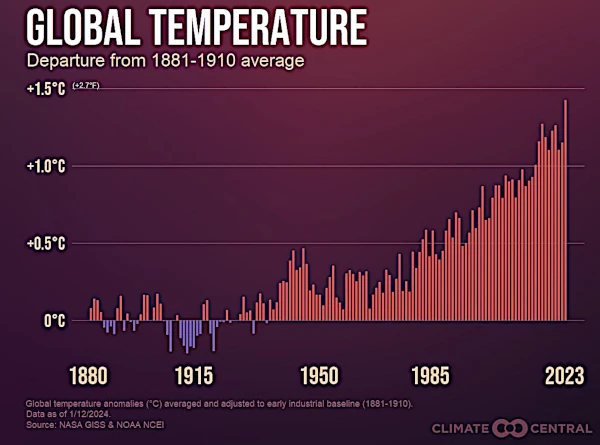
Image description: Chart showing the evolution of global temperatures since climate records began. The hottest years are the most recent, illustrating the global warming trend. Image source: Climate Central.
Since the end of the 19th century, when temperature records began, scientists have observed a clear trend of global warming. This phenomenon, known as global warming, is primarily attributed to the increase in greenhouse gases in the atmosphere, resulting from human activities such as the burning of fossil fuels, deforestation, and intensive agriculture.
Global warming is a global phenomenon that has been affecting our planet for several decades. Temperature records show a clear trend: the hottest years are occurring at an alarming rate. Understanding this evolution is crucial for addressing current and future environmental challenges.
The hottest years recorded since records began are mainly concentrated in the last three decades. Among these, 2023 holds the record for the hottest year ever recorded, closely followed by 2016, 2020, 2019, 2015, and 2017. These years saw global average temperatures exceeding pre-industrial levels (before 1880) by more than one degree Celsius.
These high temperatures have had significant impacts on the environment, including accelerated melting of glaciers and ice caps, sea-level rise, and an increase in the frequency and intensity of extreme weather events such as hurricanes, droughts, and floods.
These years mark a worrying trend, with average global temperatures exceeding seasonal norms. Temperature anomalies, i.e., deviations from the reference average (1951-1980), are increasingly positive, indicating continuous warming.
Global warming is primarily attributed to the increase in greenhouse gases in the atmosphere, notably carbon dioxide (CO2) and methane (CH4). These gases trap heat and contribute to the natural greenhouse effect, but their excessive concentration disrupts the climate balance.
Human activities, such as the burning of fossil fuels, deforestation, and intensive agriculture, are the main culprits for this increase. Rapid industrialization and population growth have accelerated these processes, exacerbating global warming.
The consequences of global warming are vast and varied. They include the melting of polar ice and glaciers, sea-level rise, more frequent and intense extreme weather events, as well as impacts on biodiversity and ecosystems.
The melting of ice contributes to sea-level rise, threatening coastal areas and low-lying islands. Heatwaves, droughts, floods, and storms are becoming more frequent and destructive, affecting populations and infrastructure. Biodiversity is also at risk, with species threatened by habitat loss and changing environmental conditions.
In 2023, global primary energy consumption reached an unprecedented level, increasing by 2.5% compared to the previous year to 172,225 TWh. At the same time, the use of fossil fuels also reached a historic peak, with an increase of 1.6% for coal and 2% for oil, exceeding 100 million barrels globally for the first time. CO2 emissions related to energy also increased by 2%, surpassing 40 gigatons for the first time.
However, it is important to note that dependence on fossil fuels is decreasing in advanced economies. In Europe, the share of fossil fuels in the primary energy mix fell below 70% for the first time since the Industrial Revolution, thanks to reduced demand and the rise of renewable energies. In the United States, a slight decrease in fossil fuel consumption was observed, although they still account for more than 80% of the country's primary energy.
Global energy demand is expected to increase by 11% (continued dynamics scenario) to 18% (slow evolution scenario) by 2050.